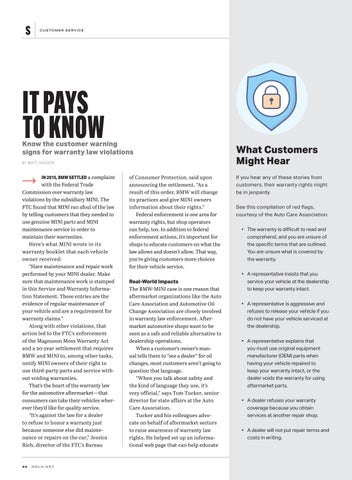S
C U STOM E R S E RVIC E
IT PAYS TO KNOW
Know the customer warning signs for warranty law violations B Y M AT T H U D S O N
IN 2015, BMW SETTLED a complaint
with the Federal Trade Commission over warranty law violations by the subsidiary MINI. The FTC found that MINI ran afoul of the law by telling customers that they needed to use genuine MINI parts and MINI maintenance service in order to maintain their warranties. Here’s what MINI wrote in its warranty booklet that each vehicle owner received: “Have maintenance and repair work performed by your MINI dealer. Make sure that maintenance work is stamped in this Service and Warranty Information Statement. These entries are the evidence of regular maintenance of your vehicle and are a requirement for warranty claims.” Along with other violations, that action led to the FTC’s enforcement of the Magnuson Moss Warranty Act and a 20-year settlement that requires BMW and MINI to, among other tasks, notify MINI owners of their right to use third-party parts and service without voiding warranties. That’s the heart of the warranty law for the automotive aftermarket—that consumers can take their vehicles wherever they’d like for quality service. “It’s against the law for a dealer to refuse to honor a warranty just because someone else did maintenance or repairs on the car,” Jessica Rich, director of the FTC’s Bureau
44
of Consumer Protection, said upon announcing the settlement. “As a result of this order, BMW will change its practices and give MINI owners information about their rights.” Federal enforcement is one area for warranty rights, but shop operators can help, too. In addition to federal enforcement actions, it’s important for shops to educate customers on what the law allows and doesn’t allow. That way, you’re giving customers more choices for their vehicle service. Real-World Impacts The BMW-MINI case is one reason that aftermarket organizations like the Auto Care Association and Automotive Oil Change Association are closely involved in warranty law enforcement. Aftermarket automotive shops want to be seen as a safe and reliable alternative to dealership operations. When a customer’s owner’s manual tells them to “see a dealer” for oil changes, most customers aren’t going to question that language. “When you talk about safety and the kind of language they use, it’s very official,” says Tom Tucker, senior director for state affairs at the Auto Care Association. Tucker and his colleagues advocate on behalf of aftermarket sectors to raise awareness of warranty law rights. He helped set up an informational web page that can help educate
What Customers Might Hear If you hear any of these stories from customers, their warranty rights might be in jeopardy. See this compilation of red flags, courtesy of the Auto Care Association. • The warranty is difficult to read and comprehend, and you are unsure of the specific terms that are outlined. You are unsure what is covered by the warranty. • A representative insists that you service your vehicle at the dealership to keep your warranty intact. • A representative is aggressive and refuses to release your vehicle if you do not have your vehicle serviced at the dealership. • A representative explains that you must use original equipment manufacturer (OEM) parts when having your vehicle repaired to keep your warranty intact, or the dealer voids the warranty for using aftermarket parts. • A dealer refuses your warranty coverage because you obtain services at another repair shop. • A dealer will not put repair terms and costs in writing.
NOLN.NET
06_Service.indd 44
6/21/22 10:12 AM





